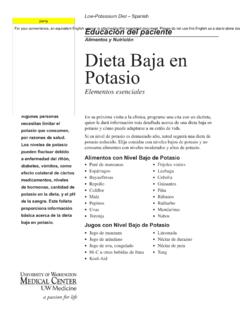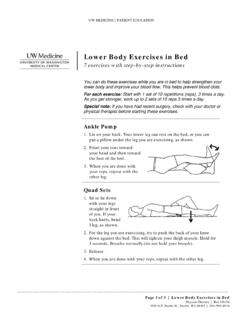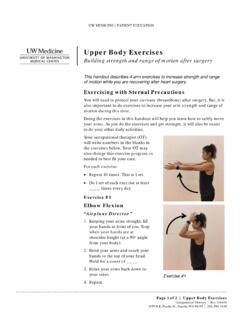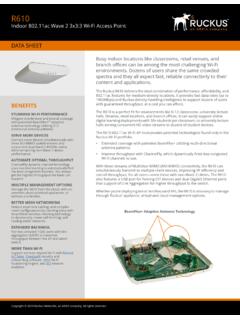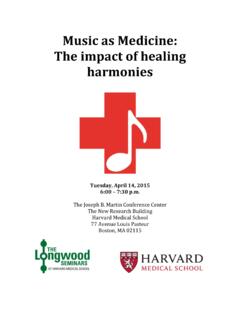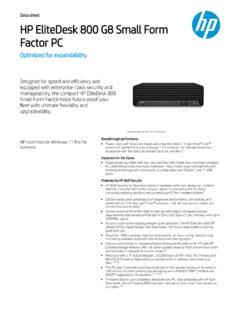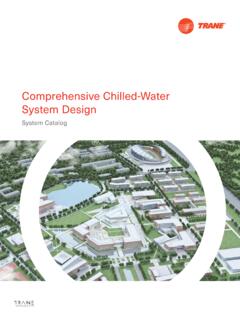Transcription of Physical Therapy After Cardiac Surgery 5 11
1 Physical Therapy After Cardiac Surgery Helping you regain your mobility This handout explains why exercise is important After Cardiac Surgery . It includes the precautions you need to follow during your recovery. Patient EducationCardiac Surgery /Regional Heart Center Your doctor will arrange for a Physical therapist to see you when it is safe for you to start exercising or moving After Surgery . This is usually the day After your Surgery , while you are still in the Intensive Care Unit (ICU). Your health care team will use information about your activity progress from the therapist to help decide your discharge date and plan.
2 It is very important that you get fully involved in the Physical Therapy program you are given. This program will help you regain your mobility and help you return to your usual living situation as soon as possible. Tell your Physical therapist if you have any concerns or any special mobility needs. You and your therapist will work together to develop an exercise program that is right for you After your Surgery . Physical Therapy Goals The goals of Physical Therapy are to teach you and your family or caregiver how to: Move safely to protect your incisions Do exercises to strengthen your muscles and manage swelling Monitor your activity level so that you exercise at the right level Increase your activity slowly and safely when you return home Precautions The most common incision used in heart Surgery divides your breastbone (sternum) down the middle.
3 The bone is then wired back together with stainless steel or titanium wire. This wire will remain in your body for the rest of your life. Page 2 Cardiac Surgery /Regional Heart Center Physical Therapy After Cardiac Surgery Your breastbone will take time to heal. This means you must avoid activities that put stress on your sternum while it is healing . For 6 weeks After Surgery , do NOT: Lift, push, or pull anything that weighs more than 10 pounds. Raise your elbows higher than your shoulders. The only exception is if you raise both arms together in front of your body.
4 Reach behind your back. To help you follow these precautions, your Physical therapist will teach you to: Get in and out of bed without using your arms Stand up from a chair and sit down without putting pressure on your arms Safely use your assistive device, such as a cane (if you use one) Safely climb stairs without pulling on the railing If you need help doing any of these things at home, your therapist will also teach your family members or caregiver how to help you correctly. Exercise in the Hospital Your therapist will prescribe an exercise program for you to start while you are still in the hospital.
5 It is important that you follow the program every day. Walking and doing your exercises will help: Your digestive, respiratory (breathing), and circulatory (blood vessel) systems recover from Surgery Reduce your risk of having complications such as pneumonia, swelling, and blood clots Increase the amount of oxygen that your heart receives, which will help it heal Improve your strength, balance, and energy Improve your mood and help you sleep better at night Bring these things to the hospital to help make Physical Therapy more comfortable.
6 Eyeglasses, if you need them for walking or reading Tennis shoes (and orthotics if you wear them) if it is uncomfortable for you to walk in stocking feet Sweatpants or shorts and a sweatshirt (or other comfortable top) that closes in the front Page 3 Cardiac Surgery /Regional Heart Center Physical Therapy After Cardiac Surgery Your Exercise Program at Home When you leave the hospital, keep doing the exercise program that your Physical therapist taught you. One of these exercises will be a walking program. Your goal is to be walking 30 to 40 minutes every day by 6 weeks After your Surgery .
7 To get the best results from your walking program: Warm up before you walk and cool down afterward. Stretch or do gentle exercises for 5 minutes before and After you walk. This will allow your heart and breathing rates to increase slowly before you walk and decrease slowly afterward. Begin walking often for short amounts of time, and slowly increase your time. - When you first get home After Surgery , walk 3 times a day for about 5 minutes each time. This is about the same distance that you walked while you were in the hospital.
8 - Every week, increase the time you walk by about 3 minutes. Exercise at a low to moderate level for 6 weeks. It is important to pace yourself when you resume activity. Slow down or rest if you are working too hard. Your Physical therapist will teach you the best way to monitor how hard your body is working. Some of these ways are: - Taking your pulse. Your pulse will tell you how hard your heart is working. It is important that your heart rate does not increase to more than 20 to 30 beats per minute above your resting heart rate.
9 - Monitoring your rate of perceived exertion (RPE) on a scale of 0 to 10. When you are exercising, think about how hard you are working, or how much effort it is taking for you to continue the activity you are doing. Rate your effort on a scale of 0 to 10, with 0 being lowest exertion and 10 being highest exertion. If you are working between levels 3 and 5, you are exercising at a low to moderate level. - Talking to someone. You can use your breathing to guide how hard you should exercise. You should not be so out of breath that you cannot carry on a conversation while you are exercising.
10 Paying attention to your body. Reduce your exercise level if you: - Have a high heart rate (pulse) for 10 minutes After you stop exercising Page 4 Cardiac Surgery /Regional Heart Center Physical Therapy After Cardiac Surgery University of Washington Medical Center Clinician Review/Published: 05/2011 Reprints on Health Online: Questions? Your questions are important. Call your health care provider if you have questions or concerns. Your Physical therapist will answer questions you might have during your Therapy sessions in the hospital.





